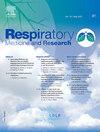慢性阻塞性肺疾病患者肺动脉高压:肺恶性膨胀对肺动脉高压治疗反应的影响
IF 1.8
4区 医学
Q3 RESPIRATORY SYSTEM
引用次数: 0
摘要
肺动脉高压(PH)在慢性阻塞性肺疾病(COPD)中很常见,特别是在严重COPD患者中。由于常见的合并症,这些患者可分为不同的PH组。肺气肿通常与COPD相关,并可导致肺恶性膨胀,这可能导致PH的发展。COPD中PH的治疗尚不明确,对治疗的反应因患者的表型而异。本研究的目的是确定慢性阻塞性肺病患者的肺恶性膨胀是否预示着对治疗的反应。方法本观察性、回顾性、单中心研究纳入诊断为PH的COPD患者,并接受PH治疗。根据肺恶性膨胀情况将患者分为两组,根据残气量与肺活量的比值进行判断。对治疗的反应定义为在6分钟步行测试中改善至少30米或在治疗开始后至少三个月进行的第一次重新评估中世界卫生组织功能等级改善1分。结果纳入的47例患者中,有30例(63.8%)患者对PH治疗有反应,“肺恶性膨胀”(HI)组与“无肺恶性膨胀”(NoHI)组之间差异无统计学意义(64.3% vs 63.2%, p = 0.937)。然而,与非肿胀患者相比,大多数肿胀患者对治疗的反应明显较低(p = 0.033)。平均总生存期为59.1个月(95% CI[47.4-70.7]),应答者的平均生存期为71.5个月(95% CI[58.6-84.5]),而应答者的平均生存期为35.4个月(95% CI [17.3-53.4], p = 0.001)。肺恶性膨胀患者的平均生存期无差异,HI患者的平均生存期为50.3个月(95% CI [35.2-65.3]), NoHI患者的平均生存期为70.4个月(95% CI [54.3-86.5], p = 0.105)。结论在COPD和PH患者中,肺恶性膨胀的存在并不能预测对PH治疗的反应。然而,高度肺恶性膨胀的患者对PAH治疗的反应明显低于无肺恶性膨胀的患者。需要进一步的研究来证实这些结果,并调查这一人群中反应的其他决定因素。临床试验注册本研究设计已在ClinicalTrials (NCT06613321)上注册。本文章由计算机程序翻译,如有差异,请以英文原文为准。
Pulmonary hypertension in patients with chronic obstructive pulmonary disease: Impact of lung hyperinflation on the response to pulmonary hypertension treatment
Background
Pulmonary hypertension (PH) is common during chronic obstructive pulmonary disease (COPD), particularly in patients with severe COPD. These patients can be classified into different PH groups due to frequent comorbidities. Emphysema is often associated with COPD and is responsible for lung hyperinflation, which may contribute to the development of PH. The treatment of PH in COPD is not well defined, and the response to treatment is variable depending on the phenotype of the patients. The aim of this study was to determine whether pulmonary hyperinflation in COPD patients predicts response to treatment.
Methods
This observational, retrospective, single-center study included COPD patients diagnosed with PH, treated with PH treatments. Patient were divided into two groups according to lung hyperinflation, judged on the ratio of residual volume to total lung capacity. Response to treatment was defined by an improvement of at least 30 m in the 6-minute walk test or a one-point improvement in World Health Organization functional class at the first reassessment performed at least three months after treatment initiation.
Results
Of the 47 patients included, 30 (63.8 %) were responders to PH treatments, with no significant difference between patients in the “lung hyperinflation” (HI) group and those in the “no lung hyperinflation” (NoHI) group (64.3 % vs. 63.2 %, p = 0.937). However, response to treatment was significantly lower in the most distended patients when compared to non-distended patients (p = 0.033). Mean overall survival was 59.1 months (95 % CI [47.4–70.7]) and was significantly better in responders, with a mean survival of 71.5 months (95 % CI [58.6–84.5]) vs. 35.4 months (95 % CI [17.3–53.4], p = 0.001). Mean survival did not differ according to lung hyperinflation, with a mean survival of 50.3 months (95 % CI [35.2–65.3]) for patients with HI, and 70.4 months (95 % CI [54.3–86.5], p = 0.105) for NoHI patients.
Conclusions
In COPD and PH patients eligible for PH treatments, the presence of lung hyperinflation did not predict response to treatment. However, patients with high degree of lung hyperinflation had a significantly poorer response to PAH treatment than patients without lung hyperinflation. Further studies are needed to confirm these results and to investigate other determinants of response in this population.
Clinical Trial Registration
The study design has been registered on ClinicalTrials (NCT06613321).
求助全文
通过发布文献求助,成功后即可免费获取论文全文。
去求助
来源期刊

Respiratory Medicine and Research
RESPIRATORY SYSTEM-
CiteScore
2.70
自引率
0.00%
发文量
82
审稿时长
50 days
 求助内容:
求助内容: 应助结果提醒方式:
应助结果提醒方式:


